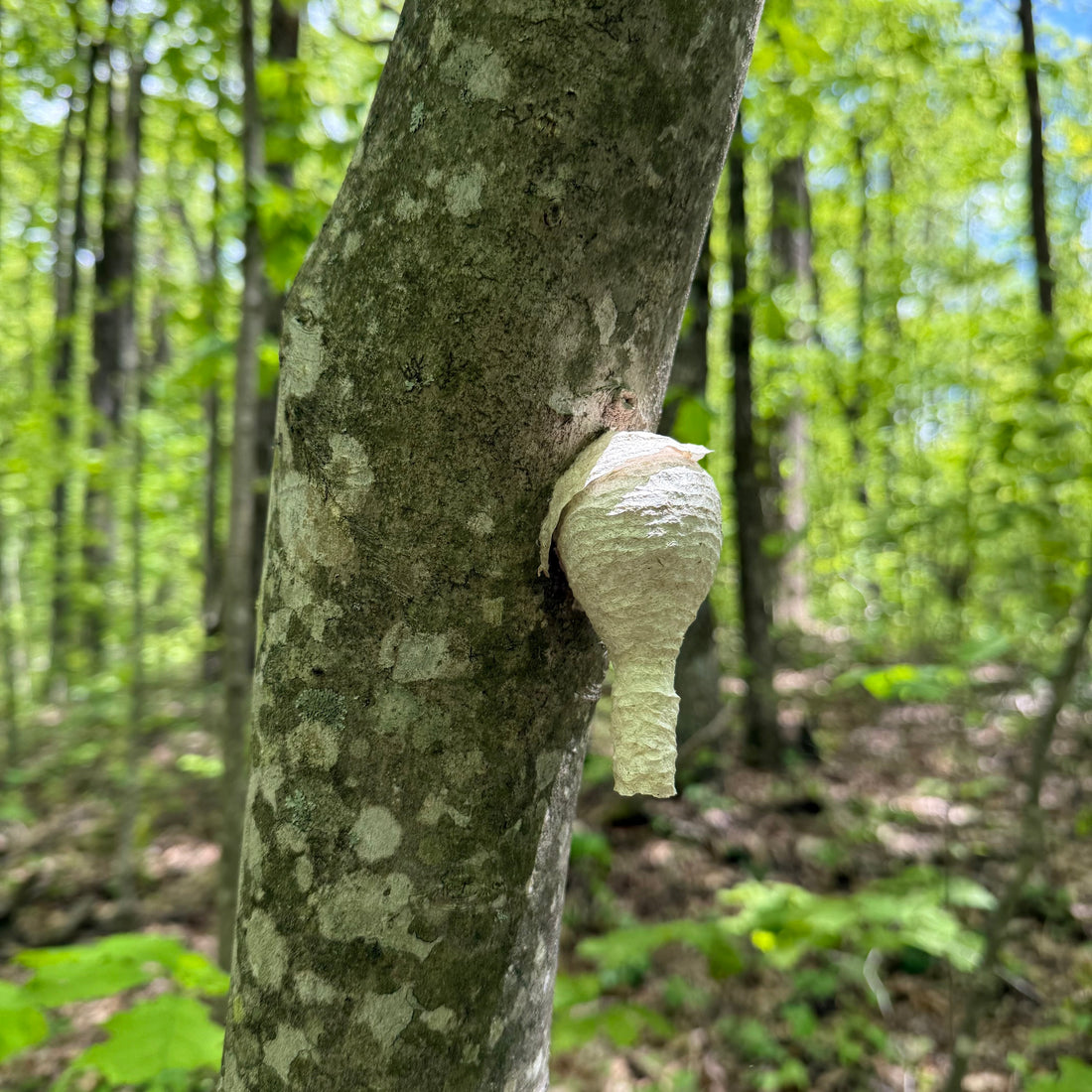I realize I am a sentimental dope, but I can’t help anthropomorphizing when I learn about things up here on the Ridge, can’t help but seeing poignant story arcs. More often than not, it results in a new soft spot in my dopey heart.
My latest affliction of affection is the Bald-Faced Hornet.
Hear me out on this—let’s see if you have any feels on the topic when I’m done.
(Caveat for the reader: I am not an entomologist or naturalist or man of any great learning.)
I was walking in the woods with some friends several weeks ago when we came across a small, strange looking nest-like object attached to a young tree at about head height. After speculating on what type of nest it was, we continued on our way. Here is a picture from that day:

I since visited the nest several times (at a safe distance) and got a few pictures of the hard working insects as their home grew in size.
Using the photos and the interwebs, I identified my neighbors as Bald-Faced Hornets. First thing I learned is that they are not hornets. They are actually wasps, closely related to the Yellowjacket. (Yeah… I don’t get it either)
But it is the rest of what I learned that really got me.
Turns out the nest we happened across was only about a week old and had been built by the queen herself. Inside that fragile little sphere of paper was a handful of gestating workers. When they emerge, maybe four weeks later, they got to work helping to expand the nest. You can see the progress in the photo below.

The nest is made of chewed up dead wood, like fallen logs or branches. (So, major recycling points for the ladies)
When the colony is thriving by the end of the summer, the nest will be the size of a football or even larger, and home to hundreds of fierce wasps. (Minimum safe distance will have expanded from what it is now!)
Then, as the days shorten and the weather cools, the plot turns.
The queen starts to produce fertile females and males. (Through the summer she has been producing primarily infertile female workers). When the few hundred young, fertile females emerge from their cells, they mate with eager males that usually travel from another nest.
Having served their only purpose, the males promptly die. The young queens try to fatten up before winter. Then, around November in these parts, the young queens leave the nest, never to return. They forge ahead alone.
As the temperatures plummet, the young queens burrow into the forest floor or a dead tree and enter a hibernation state called diapause. Get this—their bodies actually create anti-freeze proteins to ward off cell damage from extreme cold.
The old queen, back at the rapidly emptying nest, having successfully raised a colony from nothing… dies.
Her empty nest is empty. Never used again.
Months later, when the weather warms, the solitary young queens emerge from their hidden hibernation to begin the cycle all over again.
They each pick a spot, build a small starter nest on their own, begin producing workers, and race against winter to raise a colony that can support the production, rearing, and fertilization of hundreds of young queens before the cold sets in.
Why hundreds, you ask?
Because most don’t make it. Only a small fraction will survive and establish successful colonies the following year. It’s a numbers game.
That’s a tough life for a queen.
I can’t help but contrast it to the path to the throne for a honeybee queen. Briefly, for the sake of comparison, if the Bald-Faced Hornet faces a solitary survival challenge, think of the honeybee’s as a murderous gauntlet of stingers.
When a honeybee hive needs a new queen, it will produce between 10 and 20 new queen bees. (Its a very cool process involving something called “Royal jelly” we should talk about sometime) The first queen to emerge goes around and kills all her rivals by stabbing them with her long stinger while they are still in their cells. (The queen is the only bee in the hive that can sting more than once.) If multiple queens emerge at the same time. They fight to the death.
There can be only one.
Ever since we got bees, I can’t help but think about the queen’s journey every time I look at our hives down at the garden. Now that I know a little more about the Bald-Faced Hornet, I won’t be able to look at a nest the same way I used to either. Heavy lies the crown.
As I told you up front, I am not an entomologist. But I appreciate a good story when I see one. Think about the journey of one of these heroines. Born in a nest teeming with siblings, mated in flight by suitors that promptly die, she leaves the nest alone and buries herself for the winter. Waking up months later if she survives, she must navigate the wilderness on her own, searching for a place to start building a new nest. Hopefully, if all goes well, her colony will pull through so that she can pass the lonely mission on to her daughters. Finally, she will die as the young queens leave, not knowing if they will succeed.
And that harsh, poetic heroine’s journey in three acts plays out over less than twelve months. Every year.
I warned you I was an anthropomorphizing sentimental dope.

2 comments
Yes, the crown is heavy—but the path there has been thoughtful and purposeful. Life always finds a way.
Great story.